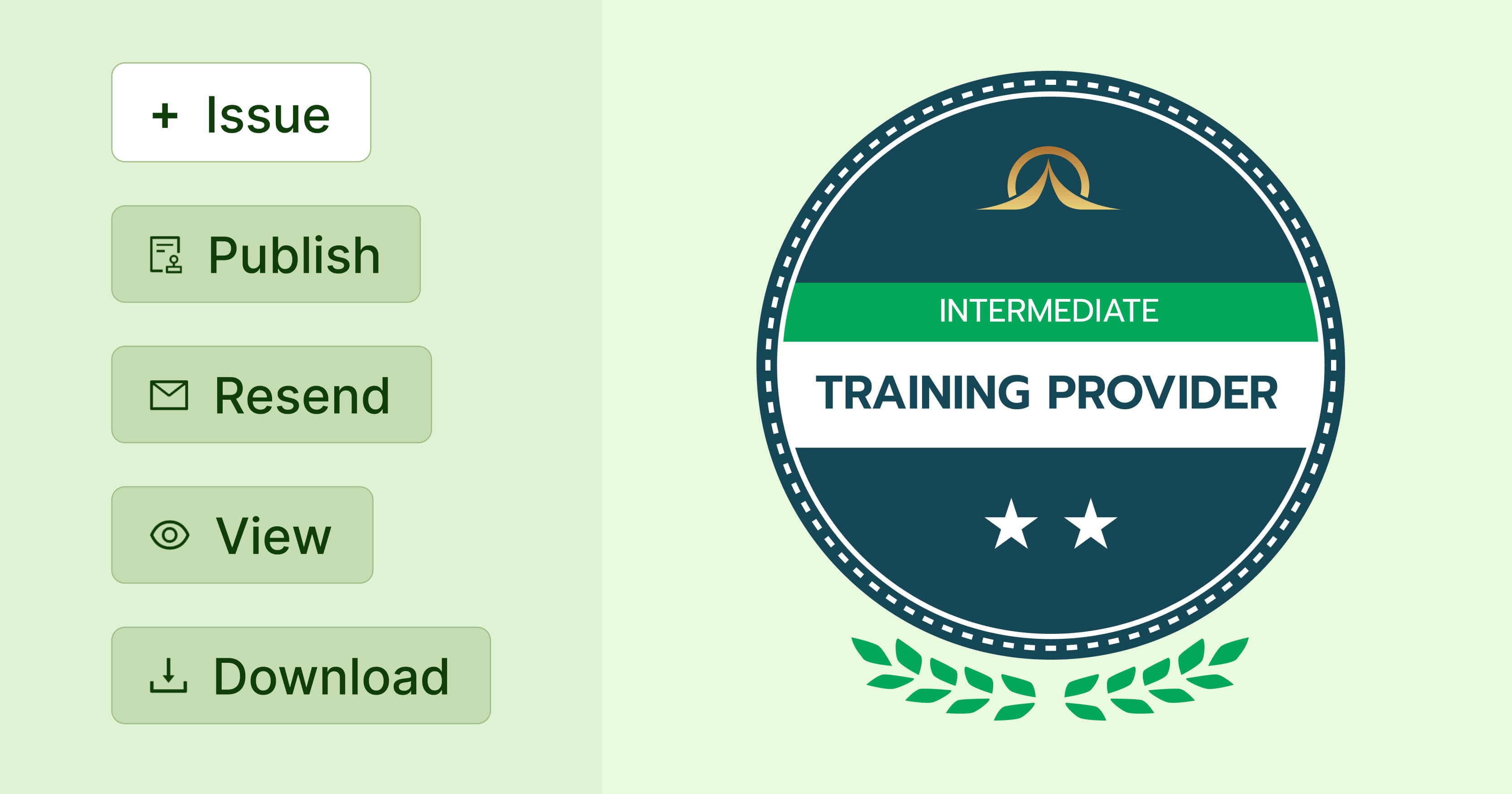Trusted by:
Search
Updated: December 05, 2025
10 min read
What Is a Digital Badge and How Is It Used?
Unlike traditional paper credentials, digital badges are dynamic, verifiable, and easily shareable. Here’s a closer look at what are digital badges and how to use them.
Today, almost everything can be shared online in seconds. From funny dog videos to groundbreaking research, the Internet has become a global platform for showing achievements.
But what if the accomplishment wasn't a hilarious dog that became viral? What if it was mastering a new coding language or completing a challenging online course?
It's time for the digital badge – instantly shared and easily verified, proving skills and dedication to the online world.
Join Certifier, as we explore what are digital badges, how exactly these badges work, and how they can truly boost the learning journey or career path.
TL;DR
Digital badges are verifiable online credentials that showcase skills and achievements in a shareable format.
They’re interactive, secure, and perfect for boosting professional visibility on LinkedIn or resumes.
Unlike traditional certificates, digital badges are lightweight, instantly verified, and built for the modern online world.
What is a digital badge?
A digital badge is a modern way to showcase achievements and skills. They’re graphical evidence of accomplishment in a specific field or area of expertise. They can be created, managed, verified, and sent online.
Think of them as the digital equivalent of the badges you earned in scouts camps or video games but for the professional milestones. They are not just pretty graphics – digital badges carry detailed information about what the recipient did to earn them.
Prefer to see it in action? Watch our quick video on what digital badges are to understand how they elevate your certification program:
The anatomy of a digital badge
The effective digital badges recognize achievement and skill through a few key elements. The following are the most significant signs that you are dealing with professional digital badge examples.
Visual badge design. The visual badge icon is the most recognizable part of a digital badge. It's essentially the badge’s image and serves as a visual representation of the achievement. This icon is designed to catch the eye and convey a purpose.
Organizations often use their logos, colors, and other branding elements in the badge design to create a strong visual identity. In this way, the digital badge serves both – as a symbol of achievements and as a promotional tool for the organization.
Metadata. It’s the detailed information embedded within the digital badge like the date when the badge was issued, the requirements for earning the certificate, and proof that the learner met the requirements. This data gives context and value to the credential.
Verification. It’s a crucial feature that sets digital badges apart from traditional credentials. Each digital badge includes a clickable link that allows others to verify its authenticity. When clicked, this link takes the viewer to a webpage (i.e. credential URL) that provides all the details about the badge.
Difference between badge and certificate: Detailed comparison
Badges and certificates both bring a lot to the table when talking about rewarding skills. They share a common goal but differ in format, usage, and impact.
Digital badge
A digital badge shows off a skill, competency, or achievement. It typically holds only a few pieces of information, like who earned it, an issuer, and sometimes even an expiration date if necessary.
Digital badges work best for quickly sharing. They fit into online profiles, social media, email signatures, and personal websites. Their compact nature makes them perfect for highlighting smaller wins or specific skills.
Certificate
A certificate brings a bit more formality. It’s an official document that verifies a completed program, course, or other big achievement.
Certificates may look professional and often include more details than badges, like the recipient's name, the program title, the date, a digital signature, a logo, a personal note, and more. They come in various formats, from digital PDFs to print-ready versions.
Let’s take a look at a comparison table depicting the difference between badge and certificate.
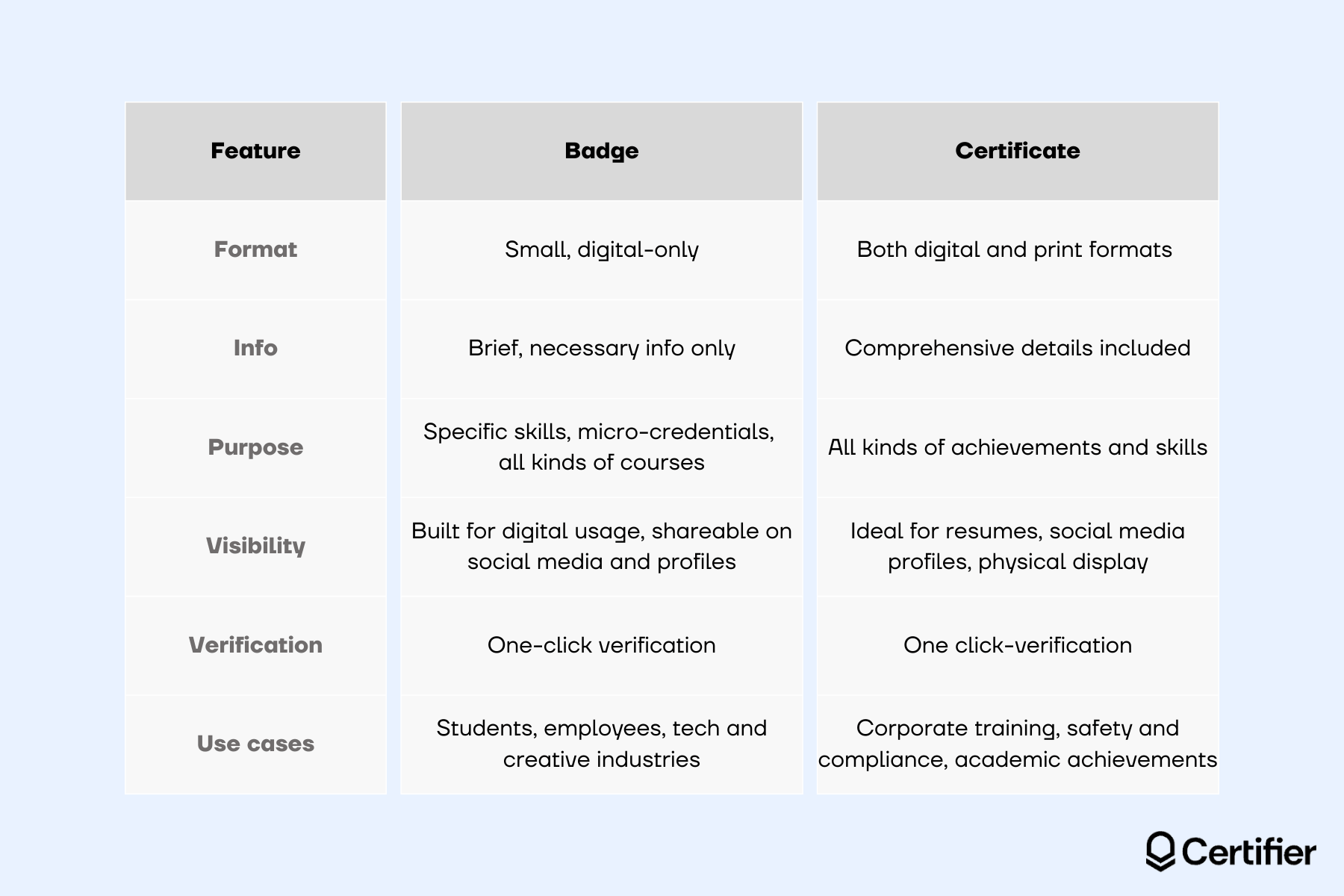
Format
Digital badge: Small and usually digital-only. Fits easily into online spaces, ready to share on LinkedIn, social media, websites, or resumes.
Certificate: More traditional and formal. Designed for both digital and physical formats. Great for printing and displaying. Also great for sharing online.
At Certifier, you can share both badges and certificates on your social media with just one click, straight from the digital wallet.
Create and Send Digital Credentials
Information provided
Digital badge: Holds only essential details like issuer info, earning criteria, and recipient data. Easy to explore.
Certificate: Lays everything out in a clear way. Shows specifics like the recipient’s name, the accomplishment, date, and official signature, a QR code. Perfect for straightforward verification.
Purpose
Digital badge: May highlight specific skills, micro-credentials, and all kinds of achievements. Professional and education badges are great for ongoing learning, showing off progress, or building up a portfolio of skills.
Certificate: It may mark bigger accomplishments, but it’s also suitable for smaller ones. Works best for academic achievements, professional training, and more comprehensive programs.
Visibility
Digital badge: Built for digital usage. Training badges are shareable across profiles, social media, digital portfolios, and suitable for email signatures. Always ready for the spotlight.
Certificate: Ideal for adding to resumes, LinkedIn profiles, or personal portfolios in document form. Offers a tangible record that can be framed or displayed.
Verification
Digital badge: Links to verification sources. Embedded metadata makes checking details easy and transparent.
Certificate: Straightforward and powerful. Digital certificates from Certifier include a one-click verification, so anyone with a smartphone can check its authenticity.
Use cases
Digital badge: More suited for industries focusing on skill recognition and micro-credentials. Popular among:
Students – Digital badges in higher education show learning progress or skills on LinkedIn and resumes.
Employees – Digital badges for employees are a great addition to online portfolios, email signatures, or social media, highlighting specific competencies.
Tech and creative industries – Digital badges for professional development are common for recognizing ongoing learning or project-based skills in areas like coding, design, and marketing.
Certificate: Perfect for formal acknowledgment of completed training or programs. Often used in:
Corporate training – Certificates verify completion of professional development programs or training sessions.
Safety and compliance – The documents certify health, safety, or legal training like first aid or industry-specific regulations.
Academic achievements – Credentials are used to recognize formal education milestones, from diplomas to specialized certifications.
Where are digital badges stored?
Digital badges are stored in what’s known as a digital wallet. This is like a virtual filing cabinet where the badge (and optionally–certificate) are kept safe and organized. Instead of having paper certificates that can get lost or forged, the recipient gets access to a secure online space from which they can download, share, or verify the credentials.
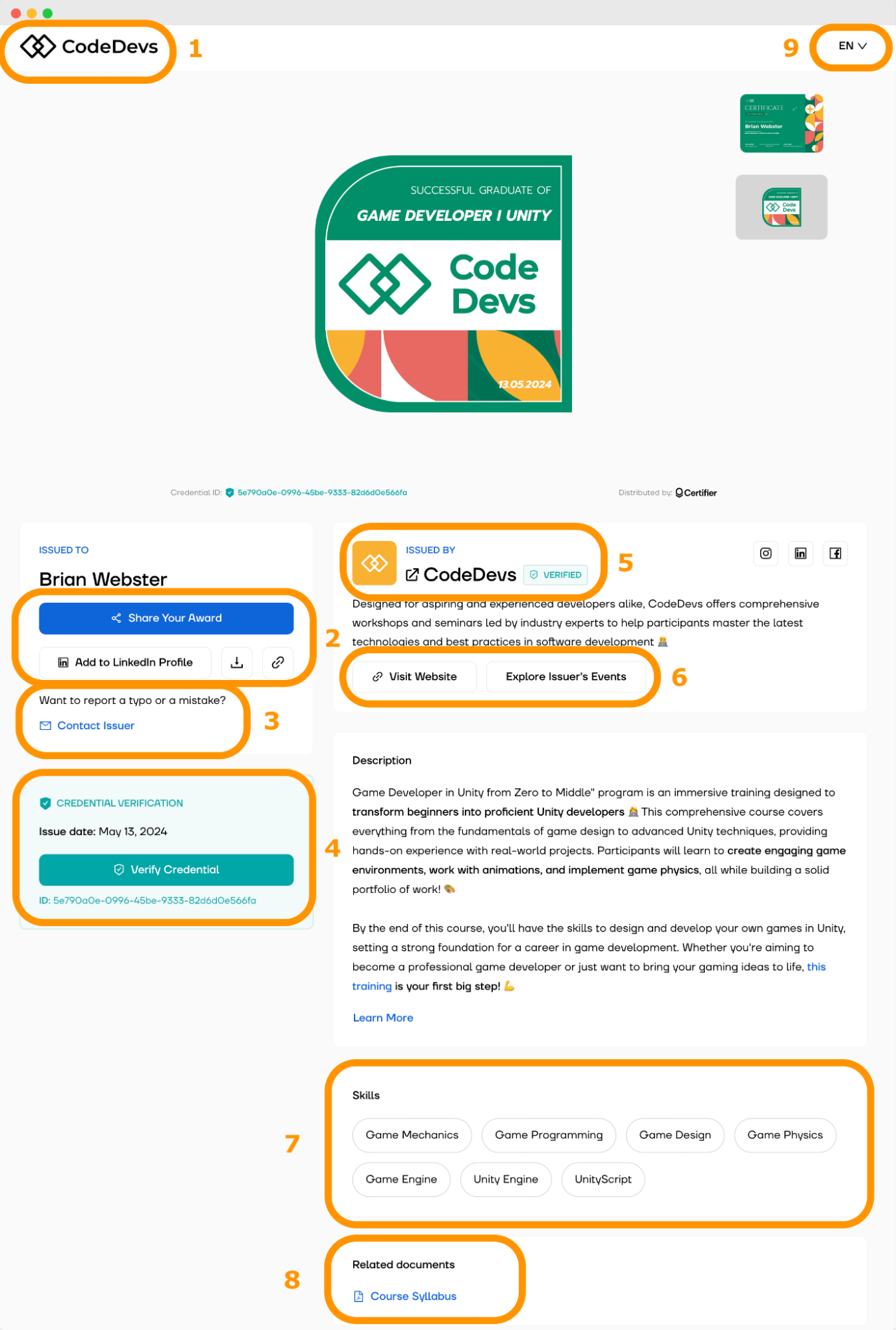
Here's how a digital wallet works:
01 Company’s logo
Digital badge issuers can upload their logo to create a professional and branded experience for the recipients.
02 Sharing buttons
Integrated buttons make it easy to share digital badges on social media like LinkedIn, Facebook and X with a single click. It’s also possible to generate a badge sharing link to the digital badge or download the credential to PDF (all the options, like the main CTA, can be changed within the issuer dashboard).
03 Typo or mistake reporting
Recipient can easily report a problem with the credential. They need to click the Contact Issuer button, then the issuer can manage the inquiry from the dashboard (badges won't need to be sent again after changes, they'll be updated automatically).
04 Credential verification
Clicking on the verification button triggers the pop-up window in which the user can see the interactive progress bar with details that determine whether the credential is valid. Scroll down to learn more.
05 Verified issuer status
The “Verified” badge next to the issuer logo indicates that the organization was checked by the Certifier team and is an authenticated credential issuer. It’s the way to build a reliable image among stakeholders.
06 Links to websites
The digital wallet can contain links to relevant websites that provide additional context and resources related to the credential.
07 Skills
Skill tags highlight the specific competencies and knowledge areas the recipient mastered. The visitor gets a quick idea of what the recipient received from earning the digital badge.
08 Additional documentation
To provide more depth, the issuer can attach extra PDF documents to the badges, such as project reports or additional materials, e.g., from the course.
09 Language settings
The wallet supports multiple languages, allowing the display of the digital badge and related information in the visitor's preferred language.
How are digital badges verified?
Verifying digital badges has made life so much easier for everyone involved. Paper certificates could get lost, damaged, or even forged, and they made it a nightmare to confirm someone’s qualifications.
But digital badges have turned the verification process into a quick and secure one.
With digital badges, you get instant verification. One click is all it takes to verify the authenticity of a badge. This not only speeds things up but also adds a layer of security since digital credentials are almost impossible to fake.
So, let's look at an example and see how it works with a certification badge website like Certifier. When the recipient earns a badge, they get an email notification with a link to the SSL-protected digital wallet. To verify the badge, anyone with access just clicks the Verify Credential button. It’s super fast and super secure.
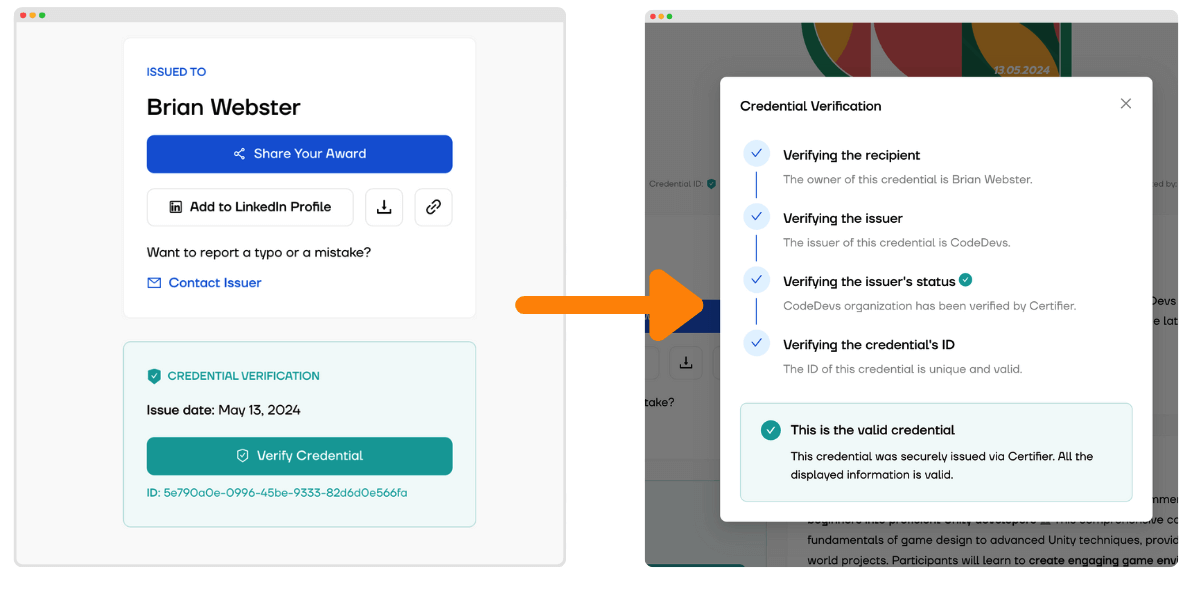
Why digital badge verification is important? Experts estimate that 4.7 billion people hold or have held fake credentials. That’s a lot of people stretching the truth! Digital badges help cut through the fibs, making sure that what you see is what you get.
How do digital badges work?
Here’s an example of digital badge workflow to give you an overview of how the process of digital badging works.
01 Issuer creates a badge
The creation of a digital badge design starts with the issuer, such as an educational institution or course provider. Using advanced online tools, a badge can be designed quickly and efficiently.
Issuers can use free badge design templates to create badges in minutes. They can also download the designs in Word, Photoshop, or vector formats. Badge designers can build a recognition template once and generate it for everyone who deserves it. They have complete control over the digital badge idea and information included in the badge.
Watch this video to learn how to create an online badge:
Create and Send Digital Credentials
02 Issuer sends a badge
Once the badge is designed, the next step is for the issuer to send the badge. To make the process smooth and without hassle, the issuer can automate the distribution by uploading the recipients’ data from the spreadsheet. They can do that both ways:
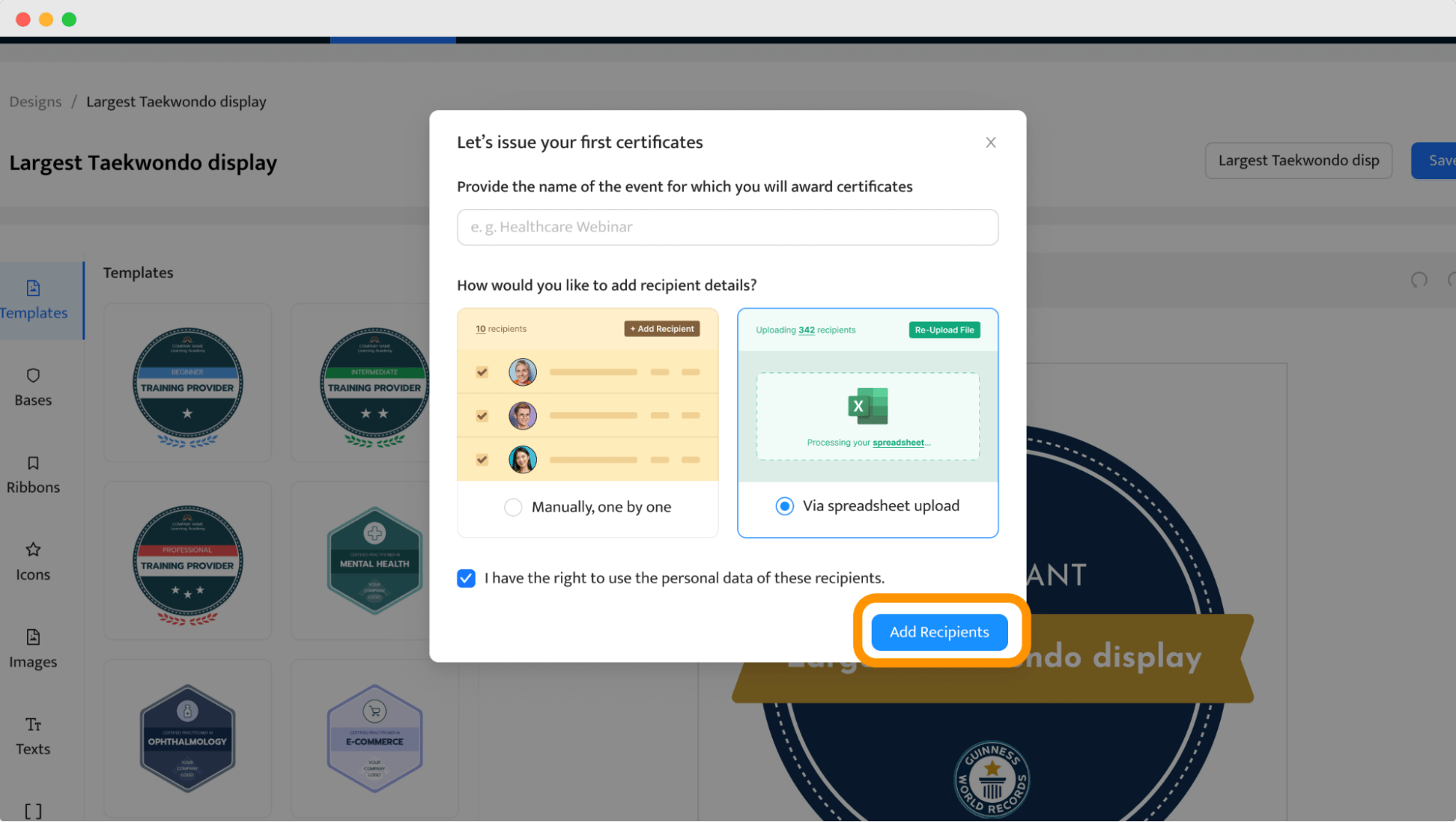
Upload the data from the spreadsheet. It’s the best way to generate hundreds of badges without errors – the tool will automatically distribute them all to the appropriate emails.
Fill out each field manually. The issuer can also manually input all the recipients’ data one by one. We don’t recommend this option if you have more than three badges to issue.
03 Recipient earns a badge
To earn a badge, the recipient needs to complete certain tasks, like finishing a course, project, or specific set of criteria. Once these are met, the organization awards the badge. An email is then sent to the recipient with instructions on how to access and share their new badge.

04 Recipient shares a badge
After receiving the badge, the recipient can share it in a few different ways.
It can be added to an email signature, so it’s visible in every email sent.

They can also post it on social media sites like LinkedIn, Twitter, or Facebook to let their network know about the achievement.
The badge can be included in a digital resume to make it stand out to potential employers.
Benefits of digital badges: Are digital badges worth it?
You already have a good understanding of digital versions of paper awards – what they do, what they are characterized by, and what data they contain. But why exactly are digital badges so popular?
They simply have a lot of benefits, and just using them is easy and intuitive.
Here are the benefits of digital badges in a nutshell:
Immediate skill verification
Convenience and 24/7 access
Attractive design
Transparency and credibility
Super fast (and eco-friendly) distribution
Enhanced professional visibility
Gamified learning experience
Immediate skill verification
One of the biggest benefits of digital badges is how they simplify the verification of skills. These credentials provide an easy way for employers and recruiters to verify one's knowledge and expertise.
They also convey all the most important information about the badge earned, such as when it was issued and by which company. This is especially useful for recruiters who are hiring for a company and looking for qualified candidates.
Instead of reading recommendations or cover letters, they can see at a glance what awards a badge recipient has and whether the skills they possess match the company's requirements.
Convenience and 24/7 access
Digital badges are incredibly convenient. They provide a quick and easy way to keep track of and store certifications online. These small files don’t take up much space and are easily accessible anytime, anywhere.
For issuers, there’s no need for technical training or printing––they can simply download the badges or create a digital portfolio to showcase all their achievements. This convenience extends to recipients who can share their badges effortlessly across various platforms so that their skills are always visible.
Attractive design
Of course, a digital badge image is also an attractive file that can take different forms, shapes, colors, etc. They are definitely prettier than a typical PDF file or paper-based certificate that contains text alone. They can be more traditional or surprise recipients with their appearance. They can also be tailored to the industry – an advertising agency may issue very creative projects, while banks will issue more standard ones.
Tip for the issuer: If you need some inspiration, you can check these free badge templates. They’re fully customizable – you can add and remove any elements you want. Change colors, fonts, and shapes until you find the perfect digital badge design.
Transparency and credibility
Another benefit of a digital badge – when recipients get their badges, the issuer can monitor how often the badge is shared and viewed, collecting vital data. This insight helps organizations understand the impact of their digital badge programs.
Digital badge platforms can track sharing, clicks, and views, providing organizations with detailed analytics as well. These analytics allow companies to generate reports, which can be used to optimize operations and improve strategies.
For example, businesses can identify the status of each badge and adjust the marketing efforts accordingly.
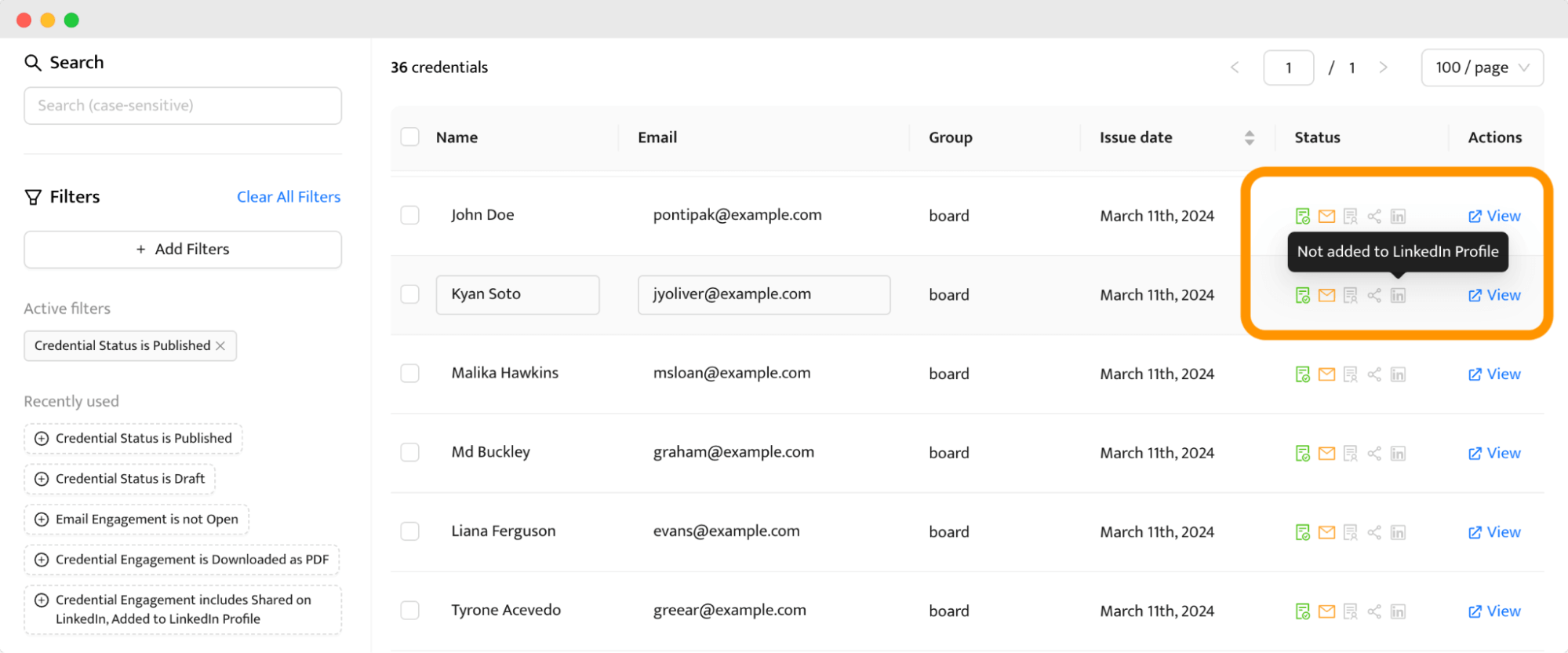
Super fast (and eco-friendly) distribution
Any digital documents, including badges, are easy to share because they can be sent with just a few clicks! It's not even a matter of minutes, but seconds to enjoy them with friends.
Sending a badge image to its owner is usually done via email. A personalized message is sent to the relevant email address with an appropriate link to the online badge file.
The best part is that automated mailing is fully customizable to each recipient – so it won't sound robotic. Within the Certifier dashboard, you can customize the email message, the branding, and the CTA button.
Digital badges meaning to be eco-friendly alternative to paper certificates. They require no physical materials, reduce waste, and lower the carbon footprint associated with the production and shipping of traditional credentials.
Enhanced professional visibility
When badge earners or certifying organizations share their digital qualifications with others (namely employers, colleagues, or licensing boards), they are essentially acting as brand ambassadors. They extend the reach of the issuing organization to a wider network.
So, for example, when it comes to digital badges for employees – when they share badges, they are also promoting the company that issued them such a credential. This can have a positive effect on increasing interest in the brand or increasing sales by buying access to courses that result in obtaining these digital awards.
Gamified learning experience
Badges are an easy, budget-friendly way to gamify any workplace or educational setting and encourage continuous improvement. These small but powerful credentials can significantly boost the quality of work and spark healthy competition among participants.
For issuers like employers and educators, digital badges are a simple and effective way to recognize achievements. From beginner to expert, they can create badges to mark their accomplishments. Different badge levels set clear goals, pushing recipients to keep improving.
What are the other types of digital awarding?
Credentialing ecosystems include more than digital badges. A number of alternative credentials exist to recognize an achievement, and many forms of digital proof are available to meet a variety of needs.
Digital certificates
A certificate degree verifies that a professional has gained a basic or advanced level of competence in a complex subject area. It assures employers that the person is capable of handling the challenges posed by the job duties. Certificate badge must be renewed periodically to complete continuing education units.
Digital diplomas
Digital diplomas are the online version of traditional diplomas awarded by educational institutions. They carry the same weight and recognition as their paper counterparts but offer the added benefits of easy distribution and verifiable degree.
The main difference between getting a credential and getting a badge is that the recipient has to take a final exam to earn it, which requires more study and commitment than getting a badge. In order to take it, they must meet certain requirements provided in long learning programs – a specific level of education and experience.
Blockchain credentials
Blockchain credentials use blockchain technology to create tamper-proof digital awards. The credentials are stored on a blockchain, which ensures their authenticity and preventing from fraud. This method is increasingly popular for high-stakes certifications and degrees.
Open badges
Open badges are a type of online badge that adheres to the Open Badges standard. They contain detailed metadata about the skills and achievements they represent and are easily shareable across various platforms. Open badges can be issued by schools, universities, companies, and organizations to recognize learning and professional development.
Credly or Certifier – which one is better? Read more about what is Credly and decide which tool suits you best.
Micro-credentials
Micro-credentials represent smaller, specific achievements within a broader field. They can be stacked to build comprehensive qualifications. These credentials are ideal for recognizing short courses, skill-specific training, and professional development milestones.
Go digital with badges
Essentially, digital badges meaning is to represent a person's competencies, along with a verifiable description of their knowledge and the activities through which they earned them. They are incredibly helpful for both – novice and already experienced employees. They are dynamic, verifiable, and easily shareable alternatives to traditional badges.
Sign up for free and start creating your own digital badges in minutes!
If you want to reward your employees or students and don't know how to do it, bet on them or other digital documents that will certify newly acquired skills.
FAQ about digital badges
Need some support? Here’s a list of the most frequently asked questions about digital badges. If you still have some concerns, contact our team or request a demo. We’re ready to help!


